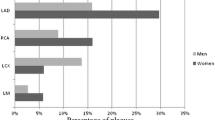Abstract
Our aim was to evaluate the plaque characteristics of coronary arteries related to significant stenosis with coronary CT angiography (CCTA) and to discuss the diagnostic accuracy of CCTA in patients with high calcium scores. After institutional review board approval, 110 patients (63 men; mean age: 67.1 ± 7.9 years) with Agatston scores >400 were retrospectively reviewed. Patients underwent Agatston calcium scoring and 64-slice CCTA, in addition to invasive coronary angiography (CAG). The composition (calcified, mixed, and non-calcified) and configuration (concentric, eccentric) of coronary artery plaques were analyzed on a per-segment basis by CCTA. We analyzed the differences in plaque composition and configuration between significant (≥50%) and non-significant (<50%) stenosis. Additionally, the diagnostic accuracy of stenosis according to plaque composition was evaluated by CCTA, using CAG as a reference method. Significant differences in plaque composition and configurations were observed between the two groups. In cases of significant stenosis, the proportions of concentric, mixed, and non-calcified plaques were significantly higher than those of eccentric and calcified plaques (P < 0.001). The sensitivity and positive predictive value of mixed (97.4, 87.6%) and non-calcified plaques (97.8, 95.7%) were significantly higher than those of calcified plaques (87.6, 67.2%). Although CCTA has limited value due to low diagnostic accuracy of calcified plaques, knowledge about the high frequencies of mixed and non-calcified plaques in significant stenosis help to make an accurate assessment of CAD with CCTA in patients with high calcium scores.



Similar content being viewed by others
References
Gussenhoven EJ, Essed CE, Lancee CT et al (1989) Arterial wall characteristics determined by intravascular ultrasound imaging: an in vitro study. J Am Coll Cardiol 14(4):947–952
Stary HC, Chandler AB, Dinsmore RE et al. (1995) A definition of advanced types of atherosclerotic lesions and a histological classification of atherosclerosis. A report from the Committee on Vascular Lesions of the Council on Arteriosclerosis, American Heart Association. Circulation 92(5):1355–1374
Budoff MJ, Achenbach S, Blumenthal RS et al (2006) Assessment of coronary artery disease by cardiac computed tomography: a scientific statement from the American Heart Association Committee on Cardiovascular Imaging and Intervention, Council on Cardiovascular Radiology and Intervention, and Committee on Cardiac Imaging, Council on Clinical Cardiology. Circulation 114(16):1761–1791
Rumberger JA, Brundage BH, Rader DJ et al (1999) Electron beam computed tomographic coronary calcium scanning: a review and guidelines for use in asymptomatic persons. Mayo Clin Proc 74(3):243–252
Palumbo AA, Maffei E, Martini C et al (2009) Coronary calcium score as gatekeeper for 64-slice computed tomography coronary angiography in patients with chest pain: per-segment and per-patient analysis. Eur Radiol 19(9):2127–2135
Greenland P, LaBree L, Azen SP et al (2004) Coronary artery calcium score combined with Framingham score for risk prediction in asymptomatic individuals. JAMA 291(2):210–215
Vliegenthart R, Oudkerk M, Hofman A et al (2005) Coronary calcification improves cardiovascular risk prediction in the elderly. Circulation 112(4):572–577
Budoff MJ, Nasir K, McClelland RL et al (2009) Coronary calcium predicts events better with absolute calcium scores than age-sex-race/ethnicity percentiles: MESA (Multi-Ethnic Study of Atherosclerosis). J Am Coll Cardiol 53(4):345–352
Nucifora G, Schuijf JD, van Werkhoven JM et al (2009) Prevalence of coronary artery disease across the Framingham risk categories: coronary artery calcium scoring and MSCT coronary angiography. J Nucl Cardiol 16(3):368–375
Zhang S, Levin DC, Halpern EJ et al (2008) Accuracy of MDCT in assessing the degree of stenosis caused by calcified coronary artery plaques. AJR Am J Roentgenol 191(6):1676–1683
Budoff MJ, McClelland RL, Chung H et al (2009) Reproducibility of coronary artery calcified plaque with cardiac 64-MDCT: the Multi-Ethnic Study of Atherosclerosis. AJR Am J Roentgenol 192(3):613–617
Chung H, McClelland RL, Katz R et al (2008) Repeatability limits for measurement of coronary artery calcified plaque with cardiac CT in the Multi-Ethnic Study of Atherosclerosis. AJR Am J Roentgenol 190(2):W87–W92
Raff GL, Gallagher MJ, O’Neill WW et al (2005) Diagnostic accuracy of noninvasive coronary angiography using 64-slice spiral computed tomography. J Am Coll Cardiol 46(3):552–557
Cademartiri F, La Grutta L, Palumbo AA et al. (2006) Coronary plaque imaging with multislice computed tomography: technique and clinical applications. Eur Radiol 16(Suppl 7):M44–53
Enrico B, Suranyi P, Thilo C et al (2009) Coronary artery plaque formation at coronary CT angiography: morphological analysis and relationship to hemodynamics. Eur Radiol 19(4):837–844
Sarwar A, Rieber J, Mooyaart EA et al (2008) Calcified plaque: measurement of area at thin-section flat-panel CT and 64-section multidetector CT and comparison with histopathologic findings. Radiology 249(1):301–306
Agatston AS, Janowitz WR, Hildner FJ et al (1990) Quantification of coronary artery calcium using ultrafast computed tomography. J Am Coll Cardiol 15(4):827–832
Di Mario C, Gorge G, Peters R et al. (1998) Clinical application and image interpretation in intracoronary ultrasound. Study group on intracoronary imaging of the working group of coronary circulation and of the subgroup on intravascular ultrasound of the working group of echocardiography of the European Society of Cardiology. Eur Heart J 19(2):207–229
Austen WG, Edwards JE, Frye RL et al. (1975) A reporting system on patients evaluated for coronary artery disease. Report of the Ad Hoc committee for grading of coronary artery disease, council on cardiovascular surgery, American Heart Association. Circulation 51(4 Suppl):5–40
Venkatesh V, Ellins ML, Yang S et al (2009) Incremental detection of coronary artery disease by assessment of non-calcified plaque on coronary CT angiography. Clin Radiol 64(3):250–255
Hausleiter J, Meyer T, Hadamitzky M et al (2006) Prevalence of noncalcified coronary plaques by 64-slice computed tomography in patients with an intermediate risk for significant coronary artery disease. J Am Coll Cardiol 48(2):312–318
Conflict of interest
None.
Author information
Authors and Affiliations
Corresponding author
Rights and permissions
About this article
Cite this article
Park, M.J., Jung, J.I., Choi, YS. et al. Coronary CT angiography in patients with high calcium score: evaluation of plaque characteristics and diagnostic accuracy. Int J Cardiovasc Imaging 27 (Suppl 1), 43–51 (2011). https://doi.org/10.1007/s10554-011-9970-7
Received:
Accepted:
Published:
Issue Date:
DOI: https://doi.org/10.1007/s10554-011-9970-7




